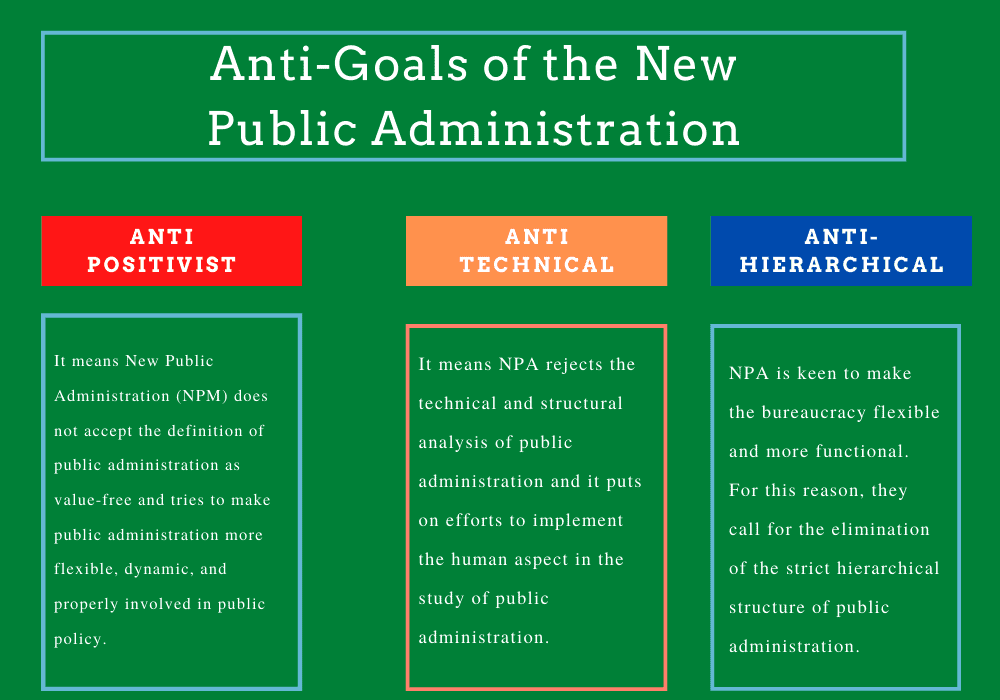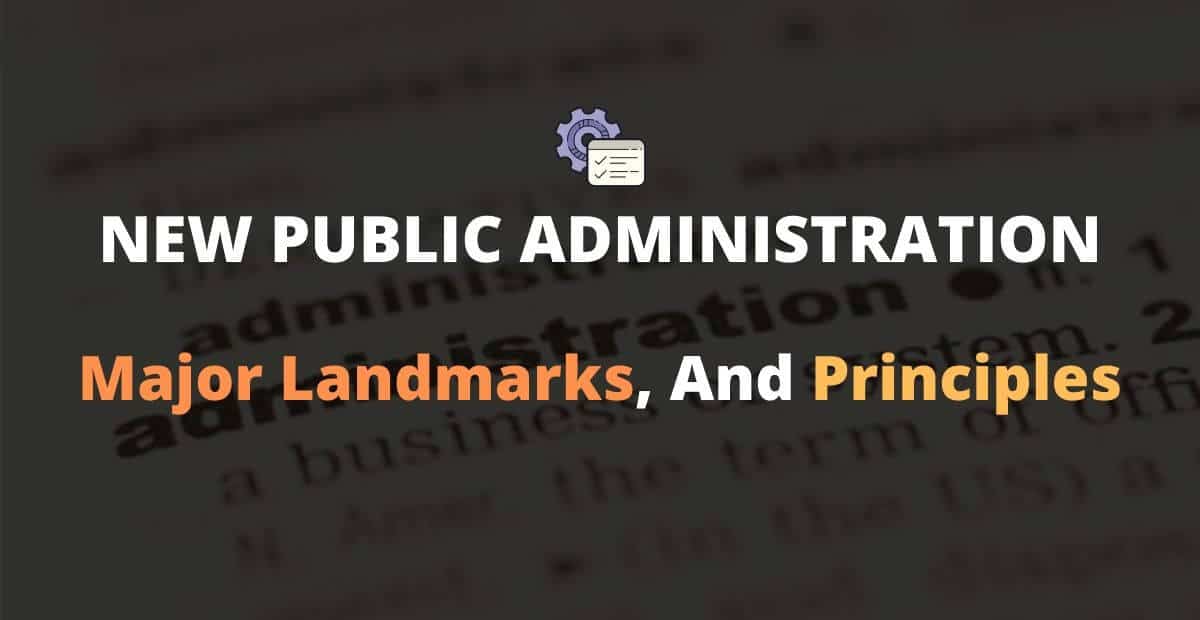New Public Administration is a new theoretical stream of public administration that emerged in the sixties of the twentieth century in response to the prevailing trend of public administration.
The movement for a new public administration was initiated by a new generation of researchers, mainly in the United States.
The delegates to the Minnowbrook Conference in the United States, led by eminent scholar and researcher Dwight Waldo, came up with a new approach, replacing the traditional managerial approach to public administration.
Must Read– Perfect Meaning, Nature, And Scope Of Public Administration
So let’s start a detailed discussion.
Table of Contents
Why New Public Administration?
During World War II, the condition of political and administrative affairs in the United States was marked by the weakness of the theory of the politics-administration dichotomy in its traditional public administration.
It is understood that the way in which public administration has so far identified politics and administration as two separate and distinct areas of practice cannot be applied in times of crisis.

Also, the way in which the old thinking of public administration repeatedly emphasized the importance of organizational policy for the efficiency of an organization, seems to be unrealistic and futile in the crisis situation during the world war.
After World War 2 a number of nations emerged (became independent from the colonial period) in the name of third-world countries. They were facing a number of problems like poverty, unemployment, nation-building, backwardness, etc.
And what was needed for them?
They needed the rapid development of their economy, the industrial, and agricultural sectors. So at that time, it was called there was a crisis after the second world war in third-world countries. So questions arose about how to develop these nations.
The Western model (traditional managerial administration) of public administration failed to overcome these crises in third-world nations.
It was a period of the 1960s. This was known as the period of crisis and turmoil in the socio-economic aspect of the United States. There was huge unemployment and traditional public administration almost gave up to resolve those problems.
So as a result in order to respond to these problems, a new approach to public administration evolves. The approach was called the New Public Administration.
Must Read- 5 Phases of The Evolution of Public Administration
What is New in New Public Administration?
Let’s differentiate the new public administration from the old one. Only then you will get a clear idea about the new public administration.
There are a number of differences between New and old public administration.
| No | Old Public Administration | New Public Administration |
| 1 | Structural and Rigid | Flexible and Dynamic |
| 2 | Focus on Principles, and maintain the status quo | Change Oriented |
| 3 | Profit Oriented | Client Oriented |
So New Public administration focuses on-
- flexible means less focus on bureaucratic structure.
- It believes in change means public administration will change when socio-economic aspects of the nation will be changed.
- It is client-oriented means public administration is more concerned about services to the people. People are seen as a client.
Major Landmarks of New Public Administration
You have already concerned that in the sixties, there was a kind of frustration among the younger generation about various government activities in the United States. On the one hand, the Vietnam War, on the other hand, the racist riots, and various social evils caused a kind of frustration in the minds of the people about all kinds of administration and institutions.
At that time, several steps were taken to make public administration more relevant. Those steps were known as the major landmark of the new public administration.
The major landmarks of new public administration are-
- Honey Report (1967)
- Philadelphia Conference (1967)
- Minnowbrook Conference (1968)
- Important Publications
Honey Report (1967)
In 1967, John C. Honey, a professor at Syracuse University, presented a comparative report based on the way public administration was taught at various universities in the United States. This report is known as Honey Report.
This report identifies four issues of public administration.
- Lack of funding for high-level research;
- Uncertainty about how the subject should be viewed – science, art, or profession;
- Most universities lack adequate infrastructure in this regard;
- Lack of communication between these two types of people, civil servants, and public administration experts;
Philadelphia Conference (1967)
In 1967, the American Academy of Political and Social Sciences organized a conference in Philadelphia. The conference discussed the theoretical and practical aspects of public administration.
The title of the topic of the Philadelphia conference was ‘The Theory and Practice of Public Administration: Scope, Objectives, and Methods’, and James C Charlesworth chaired this conference.
The following points were discussed at the conference.
- The scope of public administration is just as difficult to describe as it can be determined.
- Public administration agencies misrepresent the conflict between policy and policy administration.
- The American public administration should treat public administration in America as a discipline.
- The bureaucracy must be seen structurally and effectively.
- Training in public administration and business administration should not be combined.
- The descriptive, as well as analytical theory in public administration, is in a state of turmoil.
- Public administration has not been able to address social problems. It did not face emerging problems such as huge military-industrial complexes, riots, labor unions, stripes, etc.
Minnowbrook Conference (1968)
Some young theorists then met with their new thoughts in 1968 at the Minnowbrook Conference Center at Syracuse University in the United States under the patronage of Dwight Waldo. This Minnowbrook conference was marked as the beginning of the new public administration discussion.
The main purpose of this conference was to discuss the new theories of public administration and to identify how to give more importance to the ‘Public’ part of public administration.
There is a difference of opinion among the theorists of the conference. Nevertheless, there are some commonalities that everyone starts thinking about. They are –
- Emphasis is placed on bureaucratic decisions in policymaking.
- The bureaucracy was built as the fourth department in terms of the overall failure of the three organs of government, the legislature, the judiciary, and the executive.
- In order to meet the government’s goals, there is talk of flexibility in government work, and in that case, it is considered necessary to change the policy of gradual layout.
As an academic discipline, some important questions were raised in the conferences and tried to find the answers to those questions through discussion. Some of the important questions are-
- What standards of decision do we use to select which questions ought to be studied and how to study them?
- Who defines our questions and priorities for us?
- To what extent are we aware of the special and moral implications of knowledge in Public Administration?
- What are the uses of Public Administration as a social and political science?
- Does Public Administration presently yield knowledge useful to certain institutions in society and not to others?
Important Publications
This new movement of public administration realizes the political importance of the administration. Some publications have breathed new life into this new movement of public administration.
| Authors | Books/ Articles | Year of Publication |
| Dwight Waldo | Public Administration in a Time of Revolutions | 1968 |
| Frank Marini | Towards a New Public Administration: The Minnowbrook Perspective | 1971 |
| Dwight Waldo | Public Administration in a Time of Turbulence | 1971 |
| George Frederickson | New Public Administration | 1980 |
Dwight Waldo is considered to be the father of the New Public Administration for his precise contribution.
What are the anti-Goals of the New Public Administration?
The discussion of new public administration has started with 3 anti-goals. It means they have specifically criticized 3 aspects of traditional public administration.

- Anti Positivist
It means New Public Administration (NPA) does not accept the definition of public administration as value-free and tries to make public administration more flexible, dynamic, and properly involved in public policy.
- Anti Technical
It means NPA rejects the technical and structural analysis of public administration and it puts on efforts to implement the human aspect in the study of public administration.
- Anti-hierarchical
NPA is keen to make the bureaucracy flexible and more functional. For this reason, they call for the elimination of the strict hierarchical structure of public administration.
Goals and Principles of the New Public Administration

The goal of NPA is to achieve a total of 5 components. Many people also identify these 5 components as the principles of NPA. These are –
- Relevance
- Values
- Change
- Social Equity
- Client Orientation
1. Relevance
Conventional public administration emphasizes organizational efficiency and cost reduction. Management, on the other hand, emphasizes how to enhance the skills of staff.
The new movement of public administration seeks to highlight contemporary issues and discuss how administrative decisions are made in a particular political environment.
In this way, the weaknesses of the old public administration and management-related public administration are highlighted in the new public administration.
This new movement calls for a major overhaul of the public administration curriculum at various universities and emphasizes the relevance of public administration in modern public life.
2. Values
This new movement of public administration clearly rejects the value of neutrality in traditional public administration.
In the case of public administration, value neutrality is unrealistic, and it believes that the responsibility of the public administration towards the rustic people of the society must be discussed.
The new movement believes that the values that are established through administrative decisions should be openly acknowledged by the public administration.
The new public administration is more pro-people, more direct-oriented than its predecessors, more pro-client-oriented than institutional, and more loyal to policy than neutrality.
3. Social Equity
One of the goals of public administration is to establish equality in the society. They think that an administrator should keep in mind the impact of government work on the people. The new public administration thinks that the main goal of public administration is to alleviate the economic, social, and psychological suffering of the people.
So from this perspective, it can be called that NPA is action-oriented.
4. Change
The new public administration thinks that social integration needs a change. It is necessary to fight against stagnation and influential forces. The new public administration focuses on how to change the way administrative work is done and how to reduce bureaucratic tendencies in government institutions.
The new public administration wants to break the perpetual institutions that are slowly emerging as centers of power in society. This new movement of public administration is trying to find out how to fight against institutionalism and bureaucracy in society.
5. Client Orientation
The client refers to the citizen. The prime goal of the NPA is to provide satisfactory service to the citizens.
Features of New Public Administration
In light of the above discussion, some features of the New Public Administration (NPA) can be identified. These are –
- It is more prescriptive rather than descriptive.
- It is a value-based concept. Value is inevitable in public administration.
- It is more oriented towards changing reality.
- NPA is more flexible and dynamic.
- It is more ready to influence policies that can improve the quality of working life, as well as more competent to implement such policies.
- It is also more oriented toward clients. Her clients refer to the citizen.
- It assures the people’s participation in the decision-making process of public administration.
Conclusion of New Public Administration
From the above discussion on New Public Administration, it can be concluded that The New Public Administration was able to bring about a great change in the old way of thinking about public administration. This movement transformed public administration into a socially conscious discipline.
This movement had a special contribution, especially in developing countries. This new administration had a special significance in bringing about a qualitative change by freeing the administration from the shackles of bureaucratic red tape.
It can be clearly said that this new movement of public administration seeks to change the quality of public life, believes in a certain ideology, and seeks to alleviate the sufferings of the neglected people of society to some extent.
To the proponents of this movement, the structure of an organization and the process of action are relatively secondary; Social problems make them think a lot more. Ethics, values, new thinking, variability, and social problems, are relevant and important to the new public administration.
So let me share with you what you have learned from New Public Administration.
Share This with needful students as much as you can.
Must Read-
- New Public Management: Meaning, 10 Principles, And Features
- Good Governance: Definitions, 8 Characteristics, and Importance
- E-Governance: Meaning, Objectives, Features, and 4 Types
References
- Laxmikanth, M. Public Administration for the UPSC Civil Services Preliminary Examination. Tata McGraw-Hill Publishing Co. Ltd., 2007.
- Chakrabarty, Bidyut, and Bhattacharya, Mohit. Public Administration: a Reader. Oxford University Press, 2007.
- CHAKRABARTY, BIDYUT KANDPAL PRAKASH CHAND. PUBLIC ADMINISTRATION IN A GLOBALIZING WORLD: Theories and Practices. SAGE INDIA, 2012.
- Bhattacharya, Mohit. New Horizons of Public Administration. Jawahar Publishers & Distributors, 2011.


I like it
Thank you
Thank you so so much brother/sister!❤️❤️.. I’ve exams after 2 months and I’ve Political science in which I’ve got PubAd… I tried to watch videos by Osmania University in youtube but they were too boring for me… I was hopeless and then I Googled it and opened few articles but was disappointed and then half heartedly I clicked on your link! You saved my a**❤️
Thank you, Akash! I’m glad to know that you found the article useful.
Your totally awesome,the article is simplified,clear, organized and well understood…❤️❤️
Thank you, Halima! I’m glad to know that you found the article useful.
I have found this article so vital, it has all the content, well summarized and organized….. thanx to owner of this please
best article in a very systematic manner and covering the gist of every topic very well done.
Thanks for saving time and easily understandable notes
Awesome article for public administration. It is easy, simple and very useful for my higher study. This article saved my much time.